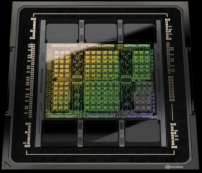Graphics Processing Units (GPUs) are crucial in accelerating data processing tasks, enabling faster and more accurate results. GPU servers are specialised machines utilising powerful GPUs to handle complex computations. They excel in machine learning, artificial intelligence, and scientific research, where massive data must be processed quickly.
The NVIDIA H100 SXM and RTX A5000 are highly regarded options for those seeking GPUs for data processing. These models offer exceptional performance and cutting-edge features that cater to the demands of modern data processing tasks.
This article provides potential renters with a comprehensive comparison of the NVIDIA H100 SXM and RTX A5000. By evaluating various criteria, such as performance, use cases, power efficiency, scalability, and cost, you will gain valuable insights when choosing a GPU server for your data processing needs.
What is a GPU server?

GPU servers are robust computing systems specifically designed to leverage the capabilities of GPUs for various computational tasks. Unlike traditional CPU servers, GPU servers have multiple high-performance GPUs that excel in parallel processing.
GPU servers offer significant advantages over CPU servers in speed and efficiency, as they can process massive amounts of data in parallel. They enable faster training and inference times for AI models, accelerate data analytics, and enhance visualization capabilities. GPU servers are widely used in industries where complex computations and data processing are essential.
They also provide the computational power to tackle demanding tasks and unlock new possibilities in data-driven applications.
What is H100 SXM?
The NVIDIA H100 SXM is a high-performance GPU designed for data processing tasks. It offers efficient resource allocation and parallel processing with Multi-Instance GPU (MIG) technology. Ideal for machine learning and high-performance computing, the H100 SXM delivers exceptional performance and scalability for handling large-scale data workloads.
Overview of NVIDIA H100 SXM
The NVIDIA H100 SXM is a high-performance GPU that offers exceptional capabilities for data processing tasks. It has advanced features and specifications, making it a top choice for demanding computational workloads.
We previously discussed that the H100 SXM is powered by the NVIDIA Hopper architecture, which delivers significant performance improvements over previous generations. One of the key innovations of the H100 SXM is its support for NVIDIA Multi-Instance GPU (MIG) technology. This allows users to partition the GPU into multiple instances, enabling efficient resource allocation and maximising utilisation. It also offers enhanced security features, such as secure boot and encrypted memory, ensuring data protection.

Overview of the NVIDIA RTX A5000
The NVIDIA RTX A5000 is a powerful GPU that delivers exceptional performance and versatility for data processing tasks. The A5000 is a good choice for data processing with its impressive specifications and advanced features.
We have previously discussed the RTX A5000 features and architecture. The A5000 is also equipped with NVIDIA Virtual Compute Server (vCS) software, allowing users to virtualise GPU resources and efficiently allocate them to multiple virtual machines. This enhances resource utilisation and flexibility in various deployment scenarios.
Comparative Analysis: NVIDIA H100 SXM vs. NVIDIA A5000
With the overview of both GPUs, you can see that the NVIDIA SXM H100 and NVIDIA RTX A5000 are great choices for data processing. Here is a detailed insight into the performance, power efficiency, scalability, and cost-effectiveness of the NVIDIA H100 SXM and the NVIDIA A5000:
- Performance: The NVIDIA H100 SXM and the NVIDIA A5000 offer impressive capabilities. The H100 SXM, with its 6,912 CUDA cores and 432 Tensor cores, delivers immense parallel processing power. The A5000, the other hand, boasts 8,192 CUDA cores and 256 Tensor cores, providing similar processing capabilities.
Here is a table comparing the NVIDIA H100 SXM vs NVIDIA RTX A5000:

- Use Cases: The H100 SXM and the A5000 are suitable for various data processing tasks. The A5000's support for NVIDIA RTX technology makes it particularly well-suited for professionals. Moreover, the H100 SMX is better suited for data centres.

- Power Efficiency: Power consumption and efficiency are important considerations for GPU servers. While specific power consumption figures may vary depending on workload and configuration, the H100 SXM Thermal Design Power (TDW) can get as high as 700 watts, while the A5000’s TDW can get as high as 300 watts. The H100 SXM and the A5000 are designed to deliver high performance while maintaining power efficiency. The NVIDIA Ampere and Hopper architectures, which power both GPUs, incorporate various power-saving features to optimise performance per watt.
- Cost: The cost of GPU servers can vary depending on rental duration, location, and service provider. When considering cost-effectiveness, it is important to evaluate the specific requirements of your data processing tasks and compare them against the performance and features offered by each GPU.
When choosing between these GPUs, it is crucial to consider specific needs, such as large-scale data processing requirements and budget constraints. Evaluating individual requirements' performance, features, scalability, and cost-effectiveness will help make an informed decision.
For organisations seeking high-performance computing with efficient resource allocation, the H100 SXM server is a strong choice. On the other hand, the A5000 is recommended for architecture, engineering, and content creation professionals, thanks to its advanced visual effects and virtualisation support.
Use the powerful NVIDIA H100 SXM and NVIDIA A5000 GPUs on CUDO Compute for your data processing needs. Take advantage of their parallel processing power, advanced features, and scalability to optimise data processing tasks. Visit CUDO Compute today and unlock the full potential of these GPUs.
Learn more: LinkedIn , Twitter , YouTube , Get in touch .
Subscribe to our Newsletter
Subscribe to the CUDO Compute Newsletter to get the latest product news, updates and insights.

